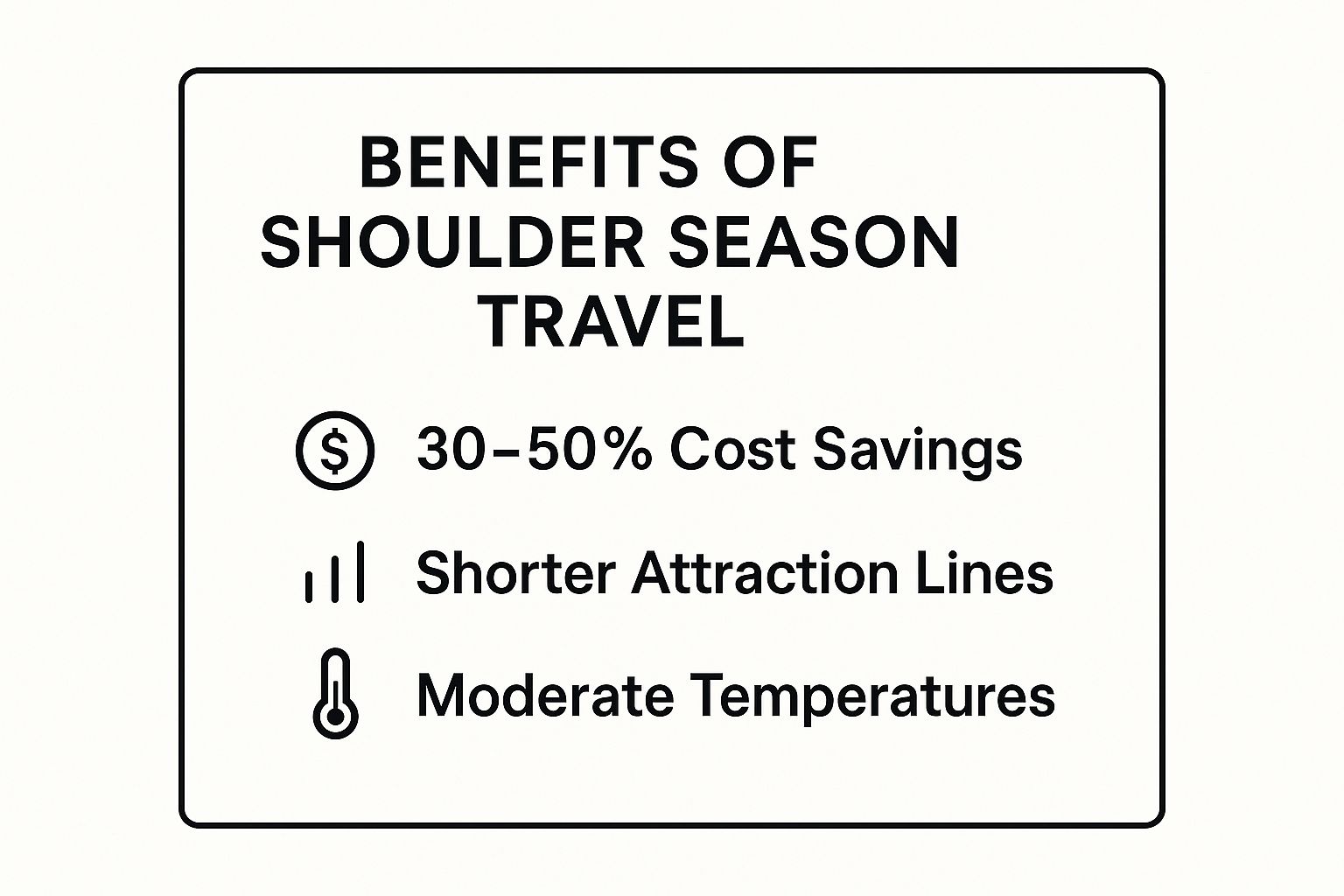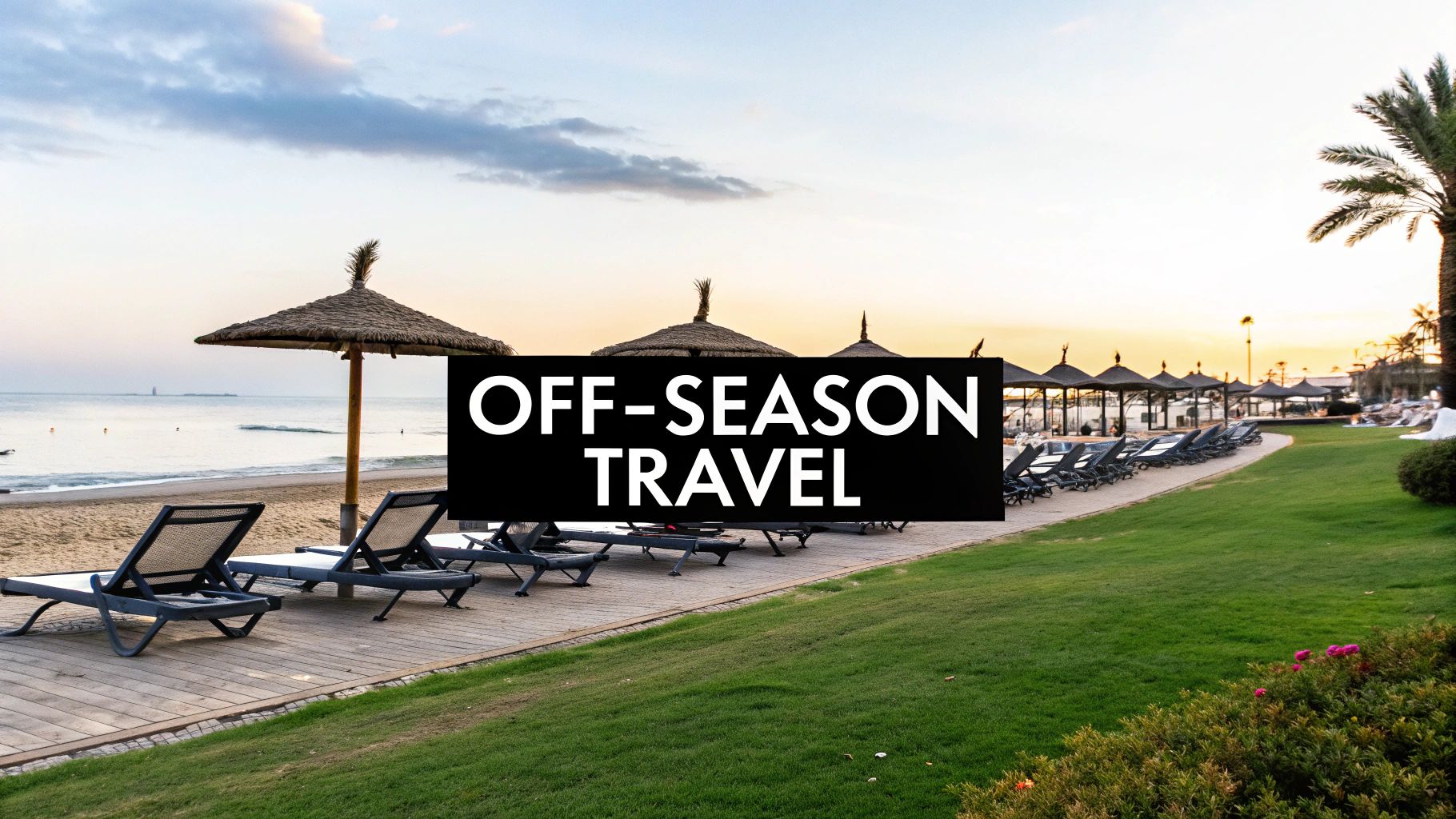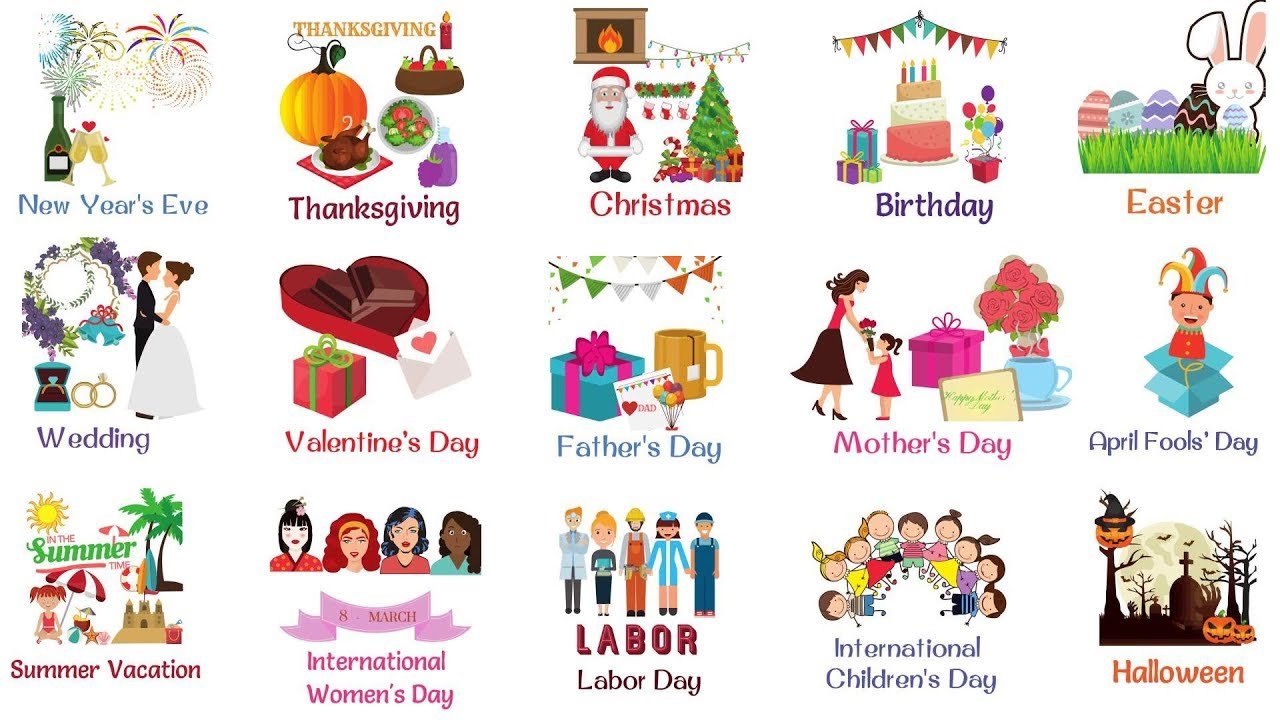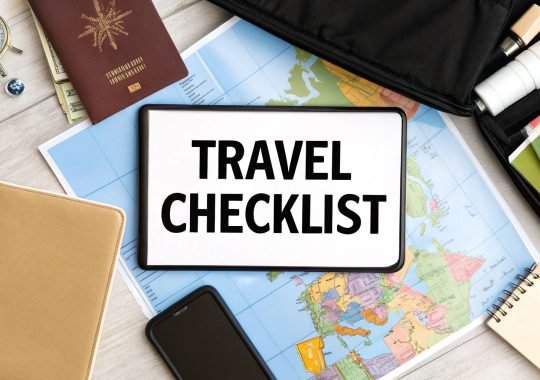Choosing the ‘best time to visit’ a destination is the cornerstone of a perfect getaway. It’s a strategic decision that influences everything from your budget and the crowds you’ll face to the memories you’ll create. Many travelers default to peak season, often overpaying for a crowded and less authentic experience. However, the real magic often happens just outside these busy windows. This guide moves beyond generic advice to provide seven actionable strategies for identifying the ideal travel time for any destination.
Whether you’re chasing sunshine, seeking cultural immersion, or simply want the best value, these proven approaches will help you time your next adventure perfectly. The principles are universal, from planning a city break to finding the ideal time to visit the Grand Canyon. We’ll explore how to leverage shoulder seasons for fewer crowds and better prices, find hidden deals by avoiding business travel peaks, and strategically plan around major events. This isn’t just about picking a month; it’s about unlocking a fundamentally better travel experience. By implementing these tactics, you ensure your next trip is your best one yet.
1. Shoulder Season Travel (April-May, September-October)
For many savvy travelers, the best time to visit a destination isn’t during the height of summer or the dead of winter. Instead, it’s during the “shoulder seasons”: the transitional months of spring (April-May) and autumn (September-October). This strategy, championed by experts like Rick Steves and publications like Lonely Planet, involves planning your trip just before or after the peak tourist rush.
The core benefit is experiencing a destination in its prime without the associated drawbacks. You get the perfect balance of pleasant weather, fewer crowds, and more affordable prices. The intense heat of summer has either not yet arrived or has gracefully subsided, leaving comfortable temperatures ideal for sightseeing and outdoor activities.
Why It’s the Sweet Spot
Imagine exploring the ancient ruins of Rome in May, with blooming flowers and mild sunshine, instead of jostling for space under the scorching August sun. Or picture a visit to Japan in late April, enjoying the pleasant spring climate after the main cherry blossom crowds have dispersed. These scenarios highlight the strategic advantage of shoulder season travel. You get a more authentic and relaxed experience, allowing you to connect with the local culture more deeply.
For a quick reference on the primary advantages, consider the following key takeaways.

These benefits collectively create a travel experience that is both more enjoyable and economically efficient.
Practical Tips for Shoulder Season Travel
To make the most of your shoulder season trip, a little advance planning goes a long way.
- Book Ahead: While prices are lower, popular spots still attract visitors. Book flights and accommodations 2-3 months in advance to secure the best rates.
- Pack in Layers: Weather can be unpredictable. A packing list that includes layers, such as a light jacket, sweater, and waterproof shell, will prepare you for any condition.
- Check Operating Hours: Some attractions, especially in smaller towns, may have reduced hours compared to the peak season. Always verify opening times online before you go.
- Embrace Local Events: Shoulder seasons often host unique local festivals and events that are not aimed at tourists, offering a fantastic glimpse into the local culture.
2. Off-Season Travel (November-March, excluding holidays)
For the truly adventurous and budget-conscious traveler, the best time to visit can often be during the off-season, typically spanning from November to March (excluding major holidays). This approach, advocated by budget travel experts like Nomadic Matt, involves embracing a destination during its quietest period. It’s a trade-off: you might encounter colder weather or seasonal rain, but in return, you gain an unparalleled sense of discovery and significant cost savings.
This strategy is about seeing a place in its most authentic, uncrowded state. It means experiencing destinations without the tourist veneer, interacting with locals who aren’t overwhelmed by visitor traffic, and enjoying major landmarks in peaceful solitude. The financial benefits are often the most compelling, with flights and accommodations sometimes costing less than half of their peak-season prices.

Why It’s the Sweet Spot
Imagine having the historic streets of Prague almost to yourself on a crisp February morning, or exploring the museums of Paris in November without waiting in endless lines. These scenarios are the reality of off-season travel. This approach is ideal for those who prioritize cultural immersion and tranquility over perfect weather. Visiting India during its monsoon season, for example, reveals lush, vibrant landscapes that are absent during the dry, peak tourist months.
The deep discounts and minimal crowds make it possible to afford longer trips or more luxurious accommodations than you could during peak times. This slower, more personal travel style fosters a deeper connection with the destination, offering a unique perspective that most tourists never see.
Practical Tips for Off-Season Travel
Success in the off-season requires smart planning and a flexible mindset.
- Research and Prepare: Weather is the biggest variable. Thoroughly research typical conditions and pack appropriately, whether it’s for the winter chill of Eastern Europe or the rain of the Caribbean’s hurricane season.
- Confirm Operating Hours: Many attractions, restaurants, and even transport services may have reduced hours or close entirely. Always verify schedules online and have backup plans.
- Embrace Indoor Activities: Choose destinations with strong indoor offerings like world-class museums, galleries, theaters, and cozy cafes to ensure you have plenty to do regardless of the weather.
- Book Flexible Tickets: Opt for flights and accommodations with flexible cancellation or change policies. This provides a safety net in case of extreme weather events that could disrupt your plans.
3. Festival and Event-Based Timing
For travelers seeking deep cultural immersion, the best time to visit is often when a destination comes alive with its most significant celebrations. This approach, heavily promoted by cultural authorities like National Geographic Travel and UNESCO, involves strategically planning your trip to coincide with a specific festival, cultural event, or seasonal celebration. While it often means navigating peak crowds and higher prices, the reward is an unforgettable, vibrant experience that showcases a region’s unique spirit and traditions.

The core benefit of this strategy is witnessing a destination at its most dynamic. You are not just a tourist; you become part of a collective celebration, gaining insights into local heritage, art, and community life that are impossible to access during quieter times of the year.
Why It’s an Unforgettable Experience
Imagine the energy of Brazil’s Carnival, the spiritual glow of India’s Diwali, or the communal joy of Thailand’s Songkran water festival. These events are not just attractions; they are the heartbeats of their respective cultures. Attending Germany’s Oktoberfest, for example, is more than just a beer festival; it’s an immersion into Bavarian traditions, food, and music that have been celebrated for centuries.
By aligning your travel with these key dates, you secure a front-row seat to a culture’s most cherished moments, creating powerful memories that last a lifetime. For a deeper dive into regional celebrations, you can find a guide to annual festivals in Orlando on hotelsescape.com.
Practical Tips for Festival Travel
Attending a major global event requires careful and early planning to ensure a smooth and enjoyable trip.
- Book Far in Advance: For world-renowned events, book flights and accommodations 6 to 12 months ahead. Prices surge and availability plummets as the date approaches.
- Confirm Event Dates: Festival dates, especially those based on lunar or religious calendars, can vary each year. Always double-check the official schedule before booking.
- Budget Accordingly: Expect premium pricing on everything from hotel rooms to local tours. Plan your budget with a buffer for these inflated event-driven costs.
- Plan for Crowds: Develop a strategy for navigating large crowds. Arrive at venues early, identify meeting points for your group, and consider booking accommodations slightly outside the city center for a quieter retreat.
4. Weather-Optimized Travel Windows
For travelers whose primary goal is to engage in specific activities, the best time to visit is dictated almost entirely by the weather. This approach, heavily relied upon by outdoor adventure companies and highlighted in resources like AccuWeather’s seasonal forecasts, involves pinpointing the exact period when climate conditions are perfect for your intended plans. It moves beyond general comfort to focus on the specific meteorological needs of an activity.
The central idea is to align your trip with the ideal temperature, precipitation, and seasonal patterns required for a particular experience. This ensures not only your comfort and safety but also the viability of the activity itself. Poor weather can completely derail a trip centered around hiking, diving, skiing, or wildlife viewing, making this strategic planning essential.
Why It’s the Sweet Spot
Imagine planning a trek in Nepal only to arrive during monsoon season, facing impassable trails and obscured mountain views. Conversely, timing your visit for the dry, clear skies of October and November guarantees a breathtaking and successful adventure. Similarly, exploring Egypt’s ancient wonders is far more pleasant in the mild winter months of December and February than during the oppressive summer heat. This method prioritizes the quality of your core experience above all else.
For a practical example of how critical weather patterns and seasons are in determining the ideal travel window for a destination, consider a local’s guide to the best time to visit Kakadu, where the transition between the wet and dry seasons dramatically alters accessibility and what you can see. The right window makes the difference between an unforgettable expedition and a logistical disappointment.
Practical Tips for Weather-Optimized Travel
To perfectly time your weather-dependent trip, detailed research and preparation are key.
- Consult Historical Data: Use weather apps and climate websites to analyze historical weather data for your destination. This provides a reliable forecast of what to expect beyond just a one-week outlook.
- Pack Appropriately: Your packing list should be tailored to the specific conditions. This could mean thermal layers and waterproof gear for a Patagonian trek or lightweight, breathable fabrics and sun protection for a trip to the Red Sea.
- Build in Flexibility: Even with careful planning, weather is unpredictable. Build buffer days into your itinerary to accommodate potential delays or to wait for better conditions for a key activity.
- Plan Backup Activities: Always have a few indoor or all-weather alternatives in mind. A rainy day doesn’t have to be a lost day if you have a museum, cooking class, or local market to explore.
5. Business Travel Avoidance Strategy
For leisure travelers eyeing urban destinations, one of the most effective ways to find the best time to visit is by thinking like a corporate traveler, and then doing the opposite. This “Business Travel Avoidance Strategy” involves timing your trip to sidestep peak business travel periods. This approach, often highlighted by hotel booking platforms and business travel publications, helps you secure better rates and enjoy a more relaxed city experience.
The core benefit lies in capitalizing on the natural lulls in corporate demand. Business travel typically peaks from Tuesday to Thursday and during major conference seasons, filling hotels and driving up prices in business districts. By planning your city break around these times, you can often find significant discounts and fewer crowds in otherwise bustling areas.
Why It’s the Sweet Spot
Imagine booking a luxury hotel room in a city’s financial district for a weekend. The same room that costs a premium for a Tuesday night stay is often available at a fraction of the price on a Friday or Saturday. This happens because business hotels need to fill rooms when their primary clientele has gone home. You get to enjoy high-end amenities and prime locations without the corporate price tag or the weekday rush.
This strategy is particularly effective in major hubs like New York, London, or Singapore, especially during summer months when corporate travel often slows down. You can enjoy a quieter, more accessible urban environment, making your sightseeing and dining experiences far more pleasant.
Practical Tips for Business Travel Avoidance
To successfully implement this strategy, a bit of targeted research and flexible planning is key.
- Target Weekends: Business-centric hotels see a sharp drop in occupancy from Friday to Sunday. Book your city stays over a weekend to access lower rates and potential perks.
- Check Conference Schedules: Before booking a trip to a major city, do a quick search for large conventions or trade shows. Avoiding these dates can save you from city-wide hotel price surges.
- Book Business Hotels: Specifically look for hotels located in financial or business districts. These properties often offer significant weekend discounts to attract leisure travelers and fill empty rooms.
- Consider “Bleisure” in Reverse: Extend a weekend trip into a Monday. You might find that Sunday night is the cheapest of all, as both business and leisure travelers are often heading home.
6. School Holiday Avoidance
For travelers seeking a quieter, more adult-focused getaway, one of the most effective strategies is actively planning trips outside of school holiday periods. This approach, often recommended by travel advisors specializing in couples’ travel and luxury publications, involves timing your vacation to miss the peak family travel windows like summer vacation, spring break, and major winter holidays. The result is a drastically different travel experience.
The core benefit of this strategy is avoiding the crowds and higher prices intrinsically linked to family travel seasons. When schools are out, demand for flights, accommodations, and attractions skyrockets, leading to inflated costs and packed venues. By identifying the best time to visit as any period when schools are in session, you unlock access to a more serene and affordable version of your chosen destination.
Why It’s the Sweet Spot
Imagine visiting Disney World in late January, enjoying walk-on rides and peaceful pathways instead of battling long lines and stroller traffic in July. Or picture exploring historic European cities in early September after local children have returned to their classrooms, allowing for unhurried museum visits and relaxed café stops. These scenarios show how sidestepping the school calendar can elevate your trip.
This timing provides a more peaceful and often more authentic atmosphere. Destinations that are typically overrun with family activities transform, offering a more tranquil environment perfect for relaxation, romance, or deep cultural immersion. You get to see a place as the locals do, not just as a seasonal tourist hub.
Practical Tips for School Holiday Avoidance
To successfully plan around the academic calendar, a bit of research is essential.
- Research International Calendars: School holidays vary significantly by country and even by region. A quick search for the academic calendar of your destination country can prevent you from accidentally booking your quiet European trip during a local school break.
- Target Adult-Oriented Destinations: While avoiding holidays helps everywhere, choosing destinations or resorts known for their adult appeal, like a Napa Valley winery or an adults-only beach resort, further guarantees a peaceful experience.
- Utilize Tracking Tools: Websites and travel resources often publish school holiday calendars for major travel markets. Use these as a preliminary guide when blocking out potential travel dates.
- Book Mid-Week Travel: Even during term time, weekends can be busier. Flying and staying from Tuesday to Thursday can often lead to even quieter conditions and better prices.
7. Early Bird and Last-Minute Booking Strategies
Determining the best time to visit a destination isn’t always about the season; sometimes, it’s about when you book. Mastering booking windows, a strategy popularized by platforms like Expedia and newsletters such as Scott’s Cheap Flights, involves a calculated decision: book far in advance for certainty and savings, or wait until the last minute to snag deep discounts on unsold inventory. Your choice depends entirely on your travel style, flexibility, and destination.
The core benefit of this approach is financial control. Early birds who book flights 3-4 months in advance or secure package deals well ahead of time are often rewarded with lower prices and better availability. Conversely, spontaneous travelers can find incredible value in last-minute cruise deals or by using apps like HotelTonight for same-day bookings, capitalizing on providers’ needs to fill empty spots.
Why It’s the Sweet Spot
Imagine securing a premium cabin on a cruise for 50% off simply because you booked within 60 days of departure when the cruise line was desperate to fill rooms. Alternatively, picture locking in your dream Parisian hotel six months early at a fantastic rate, long before seasonal demand causes prices to skyrocket. These scenarios show how timing your purchase, not just your trip, is a powerful travel hack.
This method gives you two distinct paths to value. You can either prioritize peace of mind and careful planning or embrace spontaneity for potentially greater, albeit less certain, rewards. For a deeper dive into hotel booking windows, you can find more information by learning more about the cheapest time to book hotels on hotelsescape.com. Both strategies allow you to make your travel budget stretch further.
Practical Tips for Strategic Booking
To leverage booking windows effectively, you need to be proactive and informed.
- Set Price Alerts: Use travel aggregators and airline websites to set up alerts for your desired destination. This automates the process of monitoring price drops for both early and last-minute deals.
- Be Flexible: Last-minute deals almost always require flexibility. If you can be open with your travel dates or even your destination, you dramatically increase your chances of finding an unbeatable offer.
- Book Flights First: For early-bird planning, flight prices are often the most volatile. Data suggests booking domestic flights 1-3 months out and international flights 2-8 months out for the best rates.
- Follow Deal Communities: Subscribe to newsletters and follow deal-sharing communities online. They do the hard work of finding exceptional deals and delivering them directly to you.
Best Time to Visit: 7-Strategy Comparison
| Travel Strategy | Implementation Complexity 🔄 | Resource Requirements ⚡ | Expected Outcomes 📊 | Ideal Use Cases 💡 | Key Advantages ⭐ |
|---|---|---|---|---|---|
| Shoulder Season Travel | Moderate planning, some weather unpredictability | Moderate (booking 2-3 months ahead) | Balanced cost savings, pleasant weather, fewer crowds | Travelers seeking comfort with savings and flexibility | 30-50% cost savings, shorter lines, good weather |
| Off-Season Travel | Moderate to high (weather prep, flexible plans) | Low to moderate | Lowest prices, minimal crowds, possible weather challenges | Budget travelers prioritizing cost and quiet | Up to 60% savings, peaceful experience, local vibe |
| Festival and Event-Based Timing | High (advance planning, booking 6-12 months ahead) | High (premium pricing, early reservations) | Rich cultural immersion, crowded, premium costs | Travelers focused on cultural events and unique experiences | Unique experiences, deep immersion, festive atmosphere |
| Weather-Optimized Travel Windows | Moderate (needs weather research and data) | Moderate (possible peak prices) | Ideal conditions for outdoor activities | Outdoor adventurers and photographers | Perfect weather, comfortable exploration |
| Business Travel Avoidance | Low to moderate (targeting slow business periods) | Low to moderate | Better rates, less congestion in business districts | Leisure travelers avoiding business crowds | Savings on business hotels, quieter urban areas |
| School Holiday Avoidance | Moderate (requires calendar research) | Moderate | Quieter, adult-oriented travel, fewer families | Adults seeking peaceful travel periods | Peaceful experience, lower prices, less noise |
| Early Bird and Last-Minute Booking | Moderate to high (requires flexibility and monitoring) | Low to moderate | Significant savings, risk of limited choice | Flexible travelers hunting best deals | Up to 70% savings, exclusive deals accessibility |
Your Blueprint for the Perfect Trip Timing
Navigating the complexities of travel planning can feel overwhelming, but as we’ve explored, finding the absolute best time to visit any destination is less about luck and more about strategic alignment. The traditional advice to simply “go during the summer” is a relic of the past. A truly memorable trip is one that is tailored to your specific desires, budget, and tolerance for crowds. This guide has provided you with a powerful seven-part framework to move beyond one-size-fits-all recommendations and become the architect of your own perfect journey.
Think of these strategies not as isolated tips, but as overlapping layers of a sophisticated planning filter. By combining these approaches, you can unlock unparalleled value and craft an experience that generic advice could never deliver.
Synthesizing Your Strategy for Optimal Timing
The ultimate takeaway is that the “best” time is entirely subjective. Your task is to define what “best” means to you and then use these tools to find the window that matches.
- For the Budget-Conscious Adventurer: Your primary filter will be the Off-Season (November-March). Layer this with an Early Bird Booking Strategy to lock in the lowest possible rates on flights and accommodations months in advance. The result is maximum savings.
- For the Crowd-Averse Explorer: Start by applying the School Holiday Avoidance filter. Then, narrow your options to the Shoulder Seasons (April-May, September-October). This combination ensures pleasant weather without the peak-season throngs.
- For the Cultural Enthusiast: Begin with the Festival and Event-Based Timing strategy. Identify the key cultural moments you want to experience, then cross-reference those dates with shoulder season windows to balance vibrant energy with manageable crowds.
- For the Weather-Perfectionist: Your foundation is the Weather-Optimized Travel Window. Once you have identified the months with your ideal climate, apply the Business Travel Avoidance strategy to ensure your sun-soaked getaway isn’t shared with a convention center’s worth of delegates.
Key Insight: The most powerful travel plans are created by layering multiple timing strategies. Start with your highest priority-be it budget, weather, or culture-and then apply secondary filters to refine your dates and find the perfect intersection of value and experience.
Ultimately, mastering the art of travel timing transforms you from a passive tourist into a savvy traveler. It empowers you to see the world on your terms, unlocking experiences that are richer, more affordable, and more personally fulfilling. You no longer have to settle for the most popular time; you can now pinpoint the perfect time. This strategic approach ensures your precious time off is spent creating incredible memories, not navigating predictable frustrations. Your ideal adventure is out there, waiting in a specific, discoverable window of time.
Ready to put this blueprint into action? Use the powerful search filters on HotelsEscape to compare hotel rates across different seasons, helping you instantly identify the most affordable and strategic dates for your trip. Start planning your perfectly-timed getaway today at HotelsEscape.




